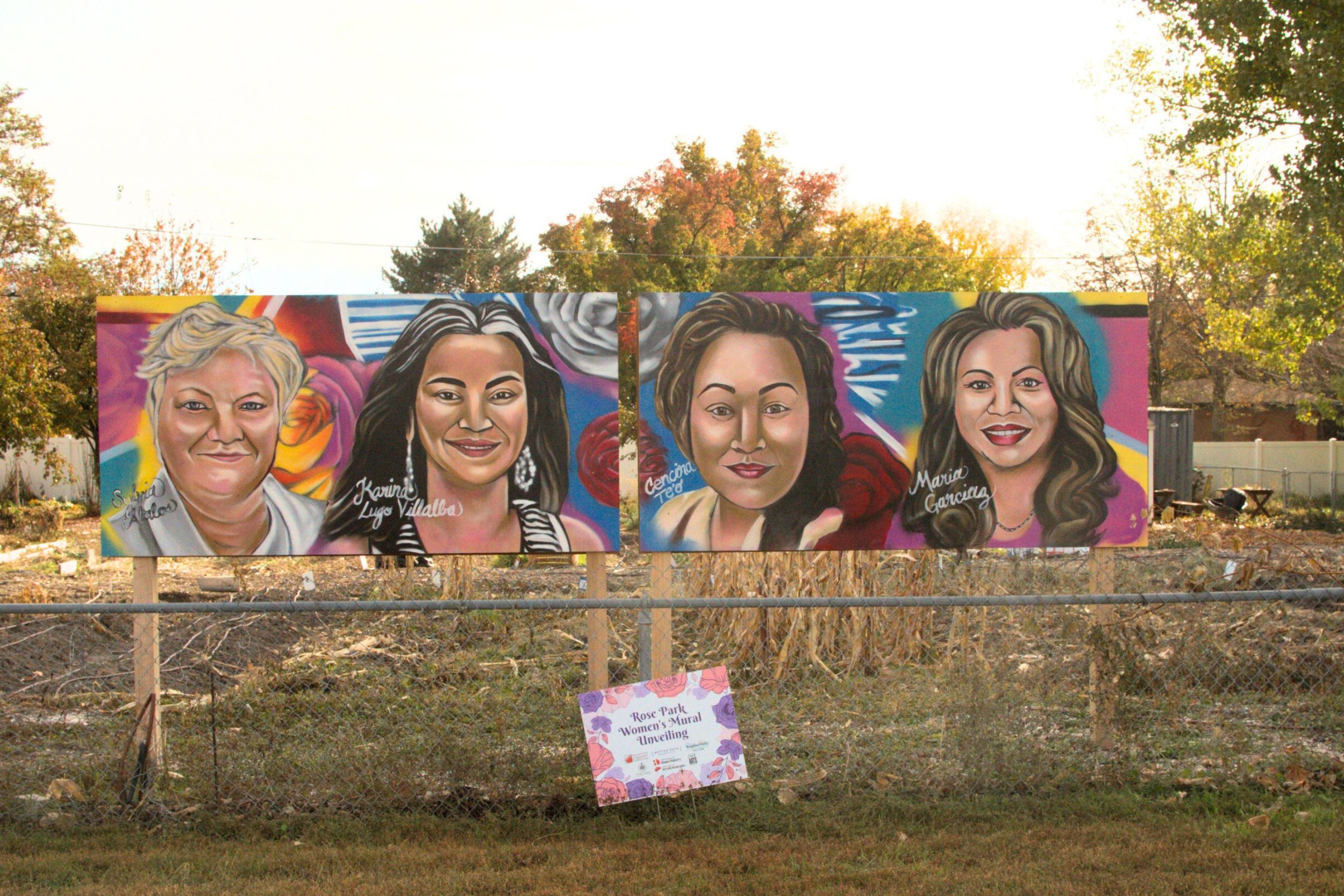Roses in the Garden mural installation features women with lasting Westside legacies
Though the seasons change around them, the Rose Park Community Garden murals remain – much like the lasting and continuing legacies of the women depicted in them. Photo by Katie McEntire.
On June 21, 2023, Westside residents gathered for the unveiling of a new art installation nestled in the Rose Park Community Garden. This fall, those murals still stand – as do the legacies of the women they depict.
Named “Roses in the Garden,” the mural features eight women who have helped shape neighborhoods throughout the Westside. Artist Bill Louis captured the strong spirit of those eight women, and now Westside residents can visit the mural whenever they like. But who are the women whose faces can be seen while strolling along the Jordan River? Their stories are woven through the fabric of the Westside.
Maria Cardenas 1922-2002
Born in Chihuahua, Mexico in 1922, Maria Cardenas grew up loving cooking alongside her mother. It was after she relocated to the United States that she met her husband, Ramon Cardenas, who shared her love of cooking. In 1966 they moved to Utah, where they eventually opened a Westside staple – Red Iguana. First advertised as a “modest cantina,” this Mexican restaurant quickly became one of the most popular restaurants in the Salt Lake Valley, and remains so to this day.
Cardenas was known to have a lot of joy in preparing meals for others and giving them the opportunity to try something new. On top of this, she also became active in the Mexican American Community in Salt Lake City. Cardenas was an artist in and out of the kitchen, using her free time to create stained glass, embroider, and make baby clothes. Cardenas passed away in 2002 and has left behind a lasting legacy within her children and Red Iguana.
Cristina Caputo 1888-1979
Many might not know that the first iteration of popular Italian Deli Caputo’s market was opened on the Westside by Cristina Caputo and her family. Born and raised in Italy and emigrating to the United States in 1913, Caputo’s husband Rosario worked in the mines in Carbon County until they had the means to move to Salt Lake and open a grocery store. Together with their 11 children, the Caputos cultivated a community pillar for over 50 years, especially for Italian Catholic families in the Fairpark area.
Cristina Caputo took over the main responsibilities for the store after her husband suffered a stroke in 1960, and after both parents passed, the Caputo children took up the mantle and opened the first Caputo’s Deli. Cristina Caputo is remembered fondly for her strong work ethic and determination, her love of chatting with local customers, and her talent for knitting sweaters, of which she is said to have knitted over 200 for friends and family.
Nettie Grimes Gregory 1890-1964
Among the women featured in Louis’ mural is Nettie Grimes Gregory. Gregory was known throughout the community as being a fierce advocate for youth and in particular young Black people on the Westside.
Gregory and her family relocated from Tennessee to Utah after William’s father was run out of town by the Ku Klux Klan. They settled in Poplar Grove so they could live in a safer place and raise their family while William continued his work on the Union Pacific Railroad. Despite seeming safer overall and with no official Jim Crow laws on the books, Black Utahns still experienced intense segregation and discrimination in their everyday lives.
In the face of such inequities, Gregory was determined to build a thriving community and safe spaces on the Westside. She focused a great deal on supporting young people and providing recreational spaces in the community, and her efforts led to the opening of the Nettie Gregory Center in Poplar Grove.
The first of its kind, the center served Salt Lake City’s Black American community until the early 2000s, offering events such as after-school programming, cultural celebrations, voter drives, sports and theater events, and many others.
Bobby Florez 1922-2010
Like many of the women featured in BetterDays2020’s projects, Bobby Florez was a trailblazer and paved the way for many women to play an active role in their communities. Florez is known in Utah as the first Hispanic woman to serve in the Utah State Legislature.
Having watched her mother serve others during the Great Depression, Florez grew up with a passion for community organizing. She also was known to host children and young people who needed a place to stay, and regularly took in children from all walks of life while also raising four children of her own.
Her husband Rey was also an active member of the community and participated in local politics, which is how Bobby ended up serving on the Utah State Legislature. After his sudden passing in 1981, Governor Matheson appointed Bobby to take Rey’s seat as a legislator for District 25 and serve on the Public Education Appropriation Committee. She went on to serve two more terms and used her community involvement to advocate for historically marginalized groups in Utah.
Cencira Te’o
Cencira Te’o pours her heart into the Westside by serving on several boards and working for several local non-profits. With a degree in Social Work from Snow College, Te’o works to empower Pacific Islander women in Utah. She is a co-founder of Pacific Islander Knowledge 2 Action Resources (Pik2ar), an organization that regularly hosts educational events about matters such as domestic violence, mentorship and entrepreneurship, and other events to celebrate Pacific Islander culture.
She has also served on the board for Neighborworks, which works to revitalize neighborhoods while preserving existing communities, and the Sorenson Multicultural Center, a Community and Recreation center that is a staple of the Westside. Te’o’s impact on the community is felt throughout the Westside, and she continues to be a strong advocate for Pacific Islander women throughout the state.
Karina Lugo-Villalba
A self-proclaimed rose in the park, Karina Lugo-Villalba has literally built bridges to safer spaces for the Westside’s children. As a lifelong resident of Rose Park, Lugo-Villalba has worked hard to create opportunities and access to resources for young people in the Valley. She was a driving force behind getting a bridge built over the Jordan River to give Backman Elementary students a safer, easier path to school, and has been a vocal advocate for families on the Westside. Lugo-Villalba has expressed a deep passion for fighting for what she believes Westside neighborhoods deserve.
Maria Garciaz
Maria Garciaz grew up watching the women in her community work hard and work tirelessly. She was encouraged by mentors to pursue an education, and has earned a bachelor’s degree from the University of Utah, a master’s degree from Utah State University, and completed a community development program at Harvard University.
The work Garciaz has done centers around supporting Utah’s young people. She went from volunteering at Neighborworks to being the CEO, where she has served for over 30 years. In this position, Garciaz has been able to address the needs of at-risk children across the Salt Lake Valley. She is a firm believer that people “can lead from the front or lead from the side or lead from behind. The goal is that no matter where you stand, you bring others along.”
Sylvia Abalos
Sylvia Abalos immigrated to Utah from Argentina and has dedicated her life to supporting Rose Park’s children. She has been described as working every day to bring joy not just to the kids in her care, but all of the kids in the community. She is able to reach so many children by working as a librarian at the Chapman Library. Through this role, Abalos works to foster confidence and curiosity within the children who come to visit the library.
In addition to caring for so many children, she’s a proud mother and grandmother and enjoys creating art. She is known by friends and neighbors as someone who is helping the children of Rose Park grow in an atmosphere that fosters a love of learning, a legacy that will impact future generations of children.

